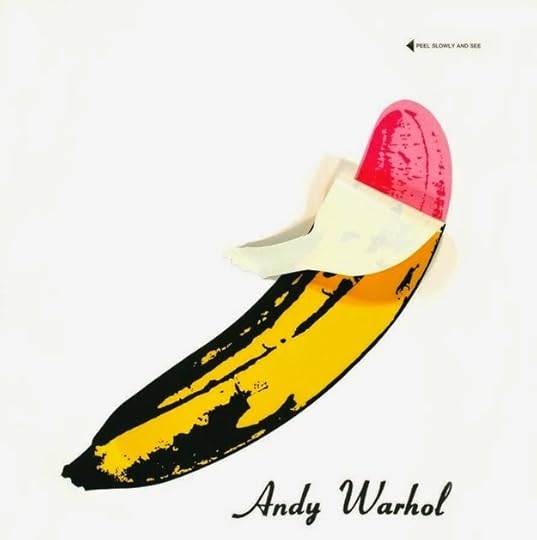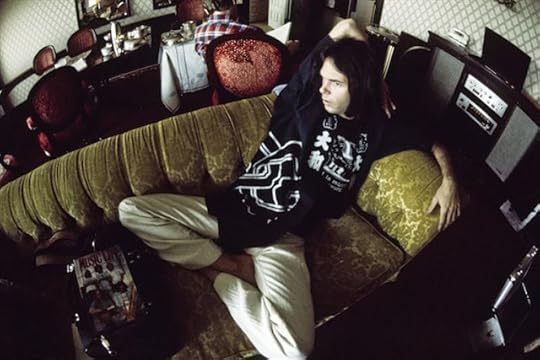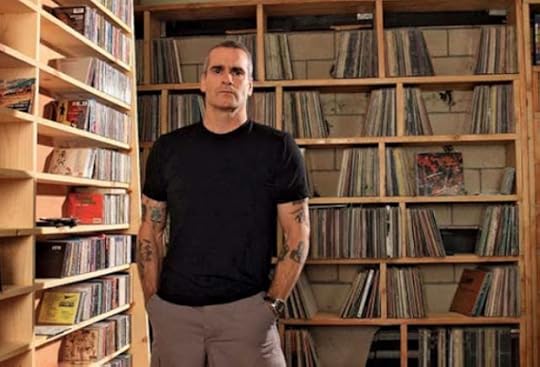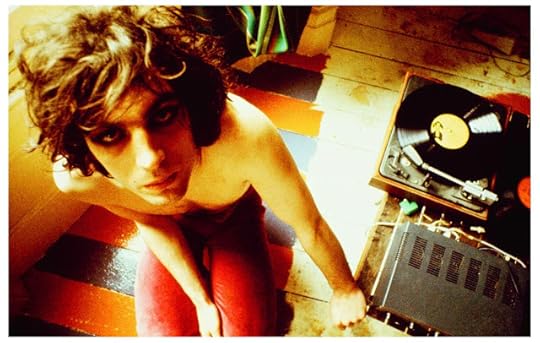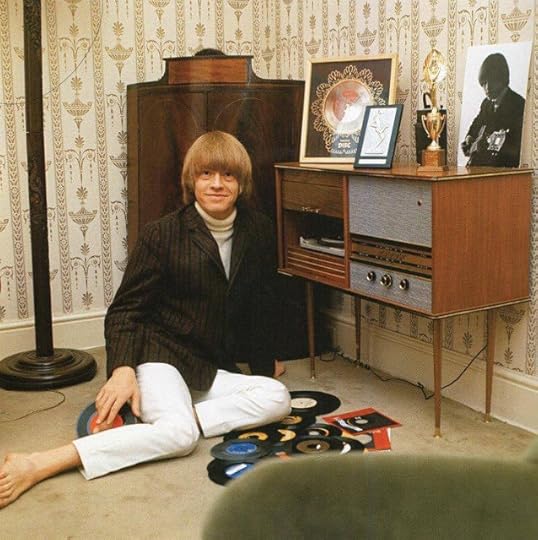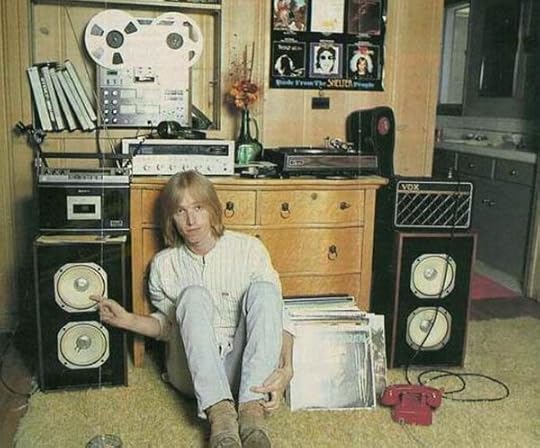R.J. Stowell's Blog: rjsomeone, page 79
April 7, 2018
The Making of...
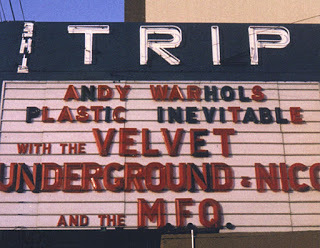 In 1966, Andy Warhol produced The Velvet Underground & Nico. The Cameo-Parkway Studios on Broadway were rented for three nights at $2500. At the time, the relationship between Lou Reed and Nico was volatile at best. Reed didn't want Nico on the album, and Nico wanted more leads. The outlook was bleak, the production of the LP contentious and awkward. John Cale was overheard saying, "Lou was paranoid and eventually he made everybody paranoid," and Andy admitted that, "The whole time the album was being made, nobody seemed happy with it." The dreary prospects for the LP continued after its completion. It was turned down by every label in the city.
In 1966, Andy Warhol produced The Velvet Underground & Nico. The Cameo-Parkway Studios on Broadway were rented for three nights at $2500. At the time, the relationship between Lou Reed and Nico was volatile at best. Reed didn't want Nico on the album, and Nico wanted more leads. The outlook was bleak, the production of the LP contentious and awkward. John Cale was overheard saying, "Lou was paranoid and eventually he made everybody paranoid," and Andy admitted that, "The whole time the album was being made, nobody seemed happy with it." The dreary prospects for the LP continued after its completion. It was turned down by every label in the city.When The Exploding Plastic Inevitable shows played The Trip in L.A. (May 3 – 18, 1966), Warhol again tried to hustle the album. Ahmet Ertegun of Atlantic Records rejected it, saying "no drug songs." Elektra rejected it, saying "no violas." (What?) Tom Wilson at Columbia was interested and had the band wait until he moved to MGM so he could release the LP on the Verve label, but that was a year in the making. MGM would also sign Zappa's Mothers of Invention at the same time. Pretty savvy, eh? Two of the 60's most influential underground bands, same guy.
 Tensions and troubles weren't confined to the studio however. The shows at The Trip were on again, off again affairs with the club closing on May 12th for non-payment of a promissory note. The band and Warhol remained in L.A. despite the show's cancellation, and for being jilted out of their fee. Union regulations stipulated that if the band remained in town for the duration of the run, they could demand payment in full for the scheduled shows. During their sojourn in L.A., the Warhol entourage stayed in a home deep in the Hollywood Hills, a large imitation-medieval stone structure known as The Castle. It was during the time of the cancelled shows that the VU completed the LP.
Tensions and troubles weren't confined to the studio however. The shows at The Trip were on again, off again affairs with the club closing on May 12th for non-payment of a promissory note. The band and Warhol remained in L.A. despite the show's cancellation, and for being jilted out of their fee. Union regulations stipulated that if the band remained in town for the duration of the run, they could demand payment in full for the scheduled shows. During their sojourn in L.A., the Warhol entourage stayed in a home deep in the Hollywood Hills, a large imitation-medieval stone structure known as The Castle. It was during the time of the cancelled shows that the VU completed the LP.There was an obvious east/west attitude that didn't set well in sunny Calif., and Lou Reed wasn't a Zappa fan, either: "He's probably the single most untalented person I've heard in my life. He's a two-bit pretentious academic, and he can't play rock 'n' roll, because he's a loser. And that's why he dresses up funny. He's not happy with himself and I think he's right." Among the celebs attending opening night were Papa John Phillips, Ryan O’Neill, Jim Morrison (while still at UCLA) and Cher who commented that the Velvet's music would replace nothing, except perhaps suicide. The Buffalo Springfield were at the midnight show after their gig at the Whiskey. Hard to contemplate that amazing and frenetic scene.
In a fabulous first-hand account of the night, waitress at The Trip, Beverly Cavaleri, said,
On May 3, 1966 I was serving drinks in the celebrity section at The Trip. Jane Fonda is seated and she orders a drink and I asked her for ID. She removes her sunglasses and says, "Do you know who I am?" People are pouring into the club to see Andy Warhol, celebrated New York avant-garde artist. Cher, Steve McQueen, John Phillips, Lou Adler and Mama's and Papa's drummer Eddie Hoe are a few of the many celebrities seated in my section. Jim Morrison of the Doors is drinking at the bar and talking with Vito and Susie Cream Cheese.
Frank Zappa and The Mothers of Invention are the opening act the first night. At the end of the set they receive a standing ovation and cheers from the audience. The Exploding Plastic Inevitable Show started after The Velvet Underground played a couple of songs. The club turned dark for a few minutes and then – like an explosion as the name implied – a light came on and off and when you could see briefly, what appeared put the audience into a state of shock. You had to pay close attention, it all moved very quickly from dark to light. When your eyes adjusted to the manipulation of the light what you saw was an interaction between Nico and two men, one who carried a whip, the other chains. It was an allusion, I think, of sadism…not at all acceptable to peace loving hippies.
People were standing up at their tables, booing as they waited their turn to leave the club. The line for the second show circled the block but the customers leaving started warning people not to go in. They said the show was vulgar and violent. The line got smaller and smaller until only a handful of people remained.
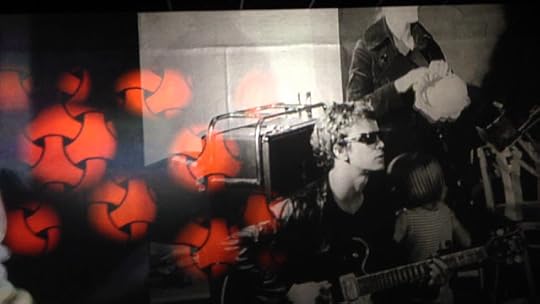 By late May the Factory crew relocated to San Francisco for a two night stint at the Fillmore, opening for The Mothers of Invention and Jefferson Airplane. The Warhol crowd hated the hippie culture of San Francisco, and the crowd hated the Velvets. Bill Graham pulled the plug on the show, literally, the second night when the band left the stage with their instruments leaning on the amplifiers creating a barrage of sonic feedback. The outspoken Lou Reed said, "We had vast objections to the whole San Francisco scene. It's just tedious, a lie and untalented. They can't play and they certainly can't write... You know, people like Jefferson Airplane, Grateful Dead are just the most untalented bores that ever came up. Just look at them physically, I mean, can you take Grace Slick seriously? It's a joke! It's a joke! The kids are being hyped."
By late May the Factory crew relocated to San Francisco for a two night stint at the Fillmore, opening for The Mothers of Invention and Jefferson Airplane. The Warhol crowd hated the hippie culture of San Francisco, and the crowd hated the Velvets. Bill Graham pulled the plug on the show, literally, the second night when the band left the stage with their instruments leaning on the amplifiers creating a barrage of sonic feedback. The outspoken Lou Reed said, "We had vast objections to the whole San Francisco scene. It's just tedious, a lie and untalented. They can't play and they certainly can't write... You know, people like Jefferson Airplane, Grateful Dead are just the most untalented bores that ever came up. Just look at them physically, I mean, can you take Grace Slick seriously? It's a joke! It's a joke! The kids are being hyped." That night Gerard Malanga was arrested in an all-night cafeteria in North Beach for carrying an offensive weapon (his whip) and spent the night in jail. He'd gone to the diner with Lou Reed and Nancy Worthington Fish, a friend of Warhol's who was performing with The Committee, a San Francisco improv troupe.
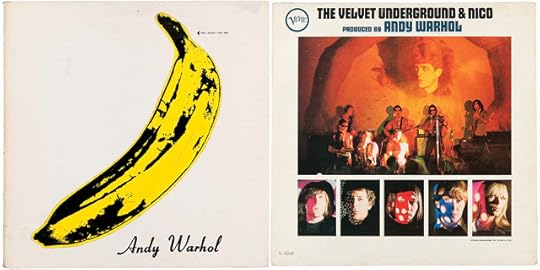
Keep in mind that The Velvet Underground & Nico wasn't released until March 1967. Retrospectively we look back at an incredible scene, a veritable vaudeville show starring Reed and Zappa and Warhol and hippies and greasers and Morrison and Steve Fucking McQueen, but the LP, an AM10, almost didn't happen.
Published on April 07, 2018 04:05
Story Goes... An LP Mistakenly Called Andy Warhol
 Edie Sedgwick and Gerard MalangaThe AM score for The Velvet Underground & Nico is a 10 (historically, one of the first). From a rubric standpoint, there are those who would reject such lofty praise, and there are indeed arguable realities: the musicianship (including Nico's vocals) is ofttimes amateurish (read that as the VU just couldn't play their instruments), and the production values and sound are sorely questionable; this isn't merely a garage sound, it verges on bootleg quality. Here, the rubric suffers in that the album is beyond reproach in terms of songwriting, influence and longevity. Retrospectively we (I speak for all of us) would change nothing. Still, no matter my opinions or the rubric's inadequacies, the album as reviewed in the Village Voice in 1967 more than questioned its value – and suggested that there was justification for the album selling a mere 30,000 copies by 1970:
Edie Sedgwick and Gerard MalangaThe AM score for The Velvet Underground & Nico is a 10 (historically, one of the first). From a rubric standpoint, there are those who would reject such lofty praise, and there are indeed arguable realities: the musicianship (including Nico's vocals) is ofttimes amateurish (read that as the VU just couldn't play their instruments), and the production values and sound are sorely questionable; this isn't merely a garage sound, it verges on bootleg quality. Here, the rubric suffers in that the album is beyond reproach in terms of songwriting, influence and longevity. Retrospectively we (I speak for all of us) would change nothing. Still, no matter my opinions or the rubric's inadequacies, the album as reviewed in the Village Voice in 1967 more than questioned its value – and suggested that there was justification for the album selling a mere 30,000 copies by 1970:Village Voice, April 13, 1967 The Velvet Underground is not an easy group to like. Some of the cuts on their album are blatant copies: I refer specifically to the progression lifted from the Rolling Stones "Hitchhike" in "There She Goes Again." The lead vocal on other songs sound distressingly like early Dylan. Some of the mterial [sic] is dull and repetitive. And the last two cuts, "Black Angel's Death Song" and "European Son" are pretentious to the point of misery.
But the Velvets are an important group, and this album has some major work behind that erect banana on the cover. "I'm Waiting for the Man" is an impressively understated vignette about scoring in Harlem. "Venus in Furs" is fine electronic mood-manifesting. "Femme Fatale" is an unearthly ballad subtly fuzzed-up to drive you mad fiddling with bass and treble switches. Nico's voice is harrowing in its pallor, but chic, very chic.
Most important is the recorded version of "Heroin," which is more compressed, more restrained than live performances I have seen. But it's also a more realized work. The tempo fluctuates wildly and finally breaks into a series of utterly terrifying squeals, like the death rattle of a suffocating violin. "Heroin" is seven minutes of genuine 12-tone rock 'n' roll.
- Richard Goldstein
Wow, really? – "pretentious to the point of misery." Wow. Here then, is the AM review:
 The Velvet Underground and Nico
(AM10)Artist: Velvet UndergroundProduced by: Andy Warhol, Tim WilsonReleased: March 12, 1967Length: 48:51Tracks: 1) Sunday Morning (2:54); 2) I’m Waiting For the Man (4:39); 3) Femme Fatale (2:38); 4) Venus in Furs (5:12); 5) Run Run Run (4:22) 6) All Tomorrow’s Parties (6:00); 7) Heroin (7:12); 8) There She Goes Again (2:41); 9) I’ll Be Your Mirror (2:14) 10) The Black Angel’s Death Song (3:11) 11) European Son (7:46)Players: Lou Reed – lead guitar, vocals; Sterling Morrison – guitars, bass; John Cale – bass, keyboards, guitar, electric viola, backing vocals, hissing; Maureen Tucker – percussion; Nico – Vocals
The Velvet Underground and Nico
(AM10)Artist: Velvet UndergroundProduced by: Andy Warhol, Tim WilsonReleased: March 12, 1967Length: 48:51Tracks: 1) Sunday Morning (2:54); 2) I’m Waiting For the Man (4:39); 3) Femme Fatale (2:38); 4) Venus in Furs (5:12); 5) Run Run Run (4:22) 6) All Tomorrow’s Parties (6:00); 7) Heroin (7:12); 8) There She Goes Again (2:41); 9) I’ll Be Your Mirror (2:14) 10) The Black Angel’s Death Song (3:11) 11) European Son (7:46)Players: Lou Reed – lead guitar, vocals; Sterling Morrison – guitars, bass; John Cale – bass, keyboards, guitar, electric viola, backing vocals, hissing; Maureen Tucker – percussion; Nico – VocalsAbrasive, dark and beautiful, the crazy ole Velvet Underground is soft like no velvet anyone's ever touched. In their shiny boots of leather you find a mixed up comfort. In their harmonies, lyrics and driving rhythms there's a nexus between all the ways we want to be hip and great and loved, and the ways we never can.
As the story goes, March 12, 1967 inarguably represents the birth of punk. Nothing else in the era compares with the VU debut. This wasn't evolutionary. The Beatles and Brian Wilson used the studio as a catalyst for their growth and artistry. Elvis tamed the raunchy alleyways of the blues; peppered it with country. But The Velvet Underground and Nico was the equivalent of skipping all the Mercury and Gemeni nonsense and blasting off to the moon with a rocket strapped to your back.
The album is riddled with a kind of nightmarish heroin dream. Songs like "Waiting For The Man" and "All Tomorrow's Parties" drive us to sway or to dance because we can. They bring us as close to tasting the underbelly of mixed up chemical love as any art ever could. "Heroin" is a crazy, Red Shoes, grim reaper's dance: the droning strings, rhythmic feedback, and twisting drums whirling to an unbridled cadence. Imagine for a moment that you are hearing this album for the first time without ever having anything to color your perception of it. Let in the other-worldliness, the beauty, like the sound of a breaking heart, the angst like all humanity simultaneously screaming to God, the desperate search for meaning in the vastness of the cosmos. OK, nix that. The Velvet Underground and Nico is too real, too empty to be anything less than art beyond reproach or comparison. This isn’t MTV; it’s empty-V.
Published on April 07, 2018 04:04
April 6, 2018
Story Goes... Brian Wilson on Rubber Soul
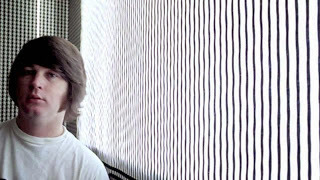 It must have been in November of 1965. I was living in this house in the Hollywood Hills then, way up on Laurel Way, and I remember sitting in the living room one night talking with some friends when another friend came in with a copy of the Beatles' new one, Rubber Soul, I don't know if it had even come out yet. But he had it and so we put it on the record player and, wow. As soon as I started hearing it I loved it. I mean, LOVED it!
It must have been in November of 1965. I was living in this house in the Hollywood Hills then, way up on Laurel Way, and I remember sitting in the living room one night talking with some friends when another friend came in with a copy of the Beatles' new one, Rubber Soul, I don't know if it had even come out yet. But he had it and so we put it on the record player and, wow. As soon as I started hearing it I loved it. I mean, LOVED it!I still remember hearing "Michelle" for the first time, and "Girl." What an incredible song! Everything about the way John Lennon sang, and the lyrics he was writing. "Oh, girl, girl." It sounded amazing.
 "Norwegian Wood" is my favorite, too. The lyrics are so good, and so creative, right from the first line: "I once had a girl/ Or should I say, she once had me." It's so mysterious. Is he into her, or she into him? It just blew my mind. And in the end, when he wakes up and she's gone, so he lights a fire. "Isn't it good? Norwegian wood." Is he setting her house on fire? I didn't know. I still don’t know. I thought that was fantastic. I can't forget the sitar, too, I'd never heard that before, that unbelievable sound. No one had heard that in rock’n’roll back then, this amazing, exotic sound. It really did inspire the instrumentation I ended up using for Pet Sounds.
"Norwegian Wood" is my favorite, too. The lyrics are so good, and so creative, right from the first line: "I once had a girl/ Or should I say, she once had me." It's so mysterious. Is he into her, or she into him? It just blew my mind. And in the end, when he wakes up and she's gone, so he lights a fire. "Isn't it good? Norwegian wood." Is he setting her house on fire? I didn't know. I still don’t know. I thought that was fantastic. I can't forget the sitar, too, I'd never heard that before, that unbelievable sound. No one had heard that in rock’n’roll back then, this amazing, exotic sound. It really did inspire the instrumentation I ended up using for Pet Sounds. So many other songs are on there, too. "You Won’t See Me" is like a cheerful pop song, and "Think for Yourself" is kind of dark. I'd forgotten that was George’s song. He really wrote that? Well, I know it has that cool fuzzy bass sound. I'd used that already on "Little Honda," so it was more familiar to me. But then came "The Word," and that was something else, too. A song about love, but not just about girls and boys.
Then there's "In My Life," that's another John song. And that's my favorite song on the record too, except for "Norwegian Wood." I loved the sound of John's voice. I'd never heard a collection of songs that were all that good before. It's like a collection of folk songs, and they're all just really, really great songs. And not just about love. They're about a lot of different things, but they all go together, somehow.
Listening to Rubber Soul didn't clarify my ideas for Pet Sounds, exactly. But it inspired me. When we were listening to it that night I said to myself, "Now I’m gonna make an album just as good as Rubber Soul." Not the same album. Obviously there can only be one album that's Rubber Soul, just like there can only be one Pet Sounds. But it inspired me to do my own thing, and so the next morning I went to the piano and wrote "God Only Knows" with Tony Asher.
And it's still my favorite Beatles album. That and Let It Be. Obviously, they're very different records. But the Beatles changed musically, and got better over the years. So did I."
Published on April 06, 2018 04:36
April 5, 2018
Story Goes... December 23, 1965; August 31, 1966
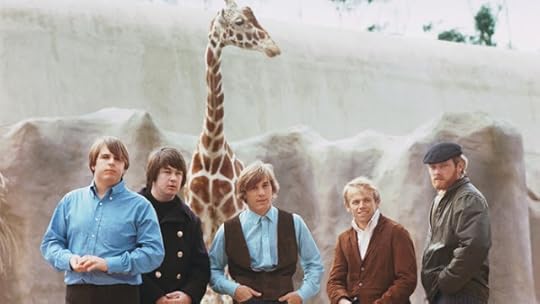 On December 23, 1964, Brian Wilson had a panic attack on a flight from L.A. to Houston while The Beach Boys were touring. Brian would subsequently bow out of any future concerts on the tour and affectively worked solely in the studio. His first venture was a song he wrote with Russ Titelman called "Guess I'm Dumb." It was the first song that created dissonance among the band members, particularly Mike Love. In 23 sessions working without the rest of the band and only with members of The Cutting Crew, Wilson revealed the intensity with which he would bring to future Beach Boys' endeavors. The band ultimately rejected the tune which would have otherwise appeared on Beach Boys Today, an album that contained the No. 1 smash "Help Me Ronda" (the spelling from the LP), as well as "Dance, Dance, Dance" and "When I Grow Up to Be a Man."
On December 23, 1964, Brian Wilson had a panic attack on a flight from L.A. to Houston while The Beach Boys were touring. Brian would subsequently bow out of any future concerts on the tour and affectively worked solely in the studio. His first venture was a song he wrote with Russ Titelman called "Guess I'm Dumb." It was the first song that created dissonance among the band members, particularly Mike Love. In 23 sessions working without the rest of the band and only with members of The Cutting Crew, Wilson revealed the intensity with which he would bring to future Beach Boys' endeavors. The band ultimately rejected the tune which would have otherwise appeared on Beach Boys Today, an album that contained the No. 1 smash "Help Me Ronda" (the spelling from the LP), as well as "Dance, Dance, Dance" and "When I Grow Up to Be a Man."Wilson ultimately gave the song to Glen Campbell as a "gift" for filling in for him on the Beach Boys' tour. While offering the first truly vibrant displays of Wilson as a producer, the song failed to chart for Campbell. It's an incredible track and the first production that hinted at a Beach Boy future that included Pet Sounds.
The Beatles live gigs ended on August 31, 1965 at Candlestick Park in San Francisco. Like Wilson before them, touring was unpopular for each of the Fab Four and in September the band retreated into the studio. The result was the most sophisticated of rock offerings up to that time with The Beatles and George Martin creating a truly flawless rock LP in the form of Rubber Soul. Rubber Soul, of course, inspired Pet Sounds which led The Beatles to Pepper, which led Brian Wilson to SMiLE. It sounds like Matthew from the New Testament, and in the rock pantheon, it has that stature.
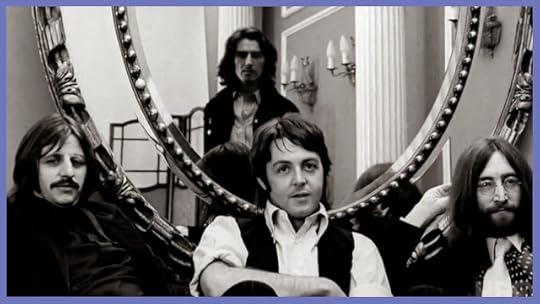
In April '67, Paul McCartney, along with Mal Evans and a few roadies, were in L.A. discussing record stuff with Capitol and happened upon a session for one of the SMiLE tracks, "Vegetables." McCartney asked if he could hang back and observe the session; he was still enamored with Pet Sounds (and in particular, "God Only Knows") and was already hearing rumors of "SMiLE's greatness." He even participated in the session as the one chomping on celery. Afterwards, McCartney played Wilson an acetate of "A Day in the Life." Wilson was in shambles after hearing the song and it only fueled the paranoia and insecurity that was rapidly growing at the time. Lennon and McCartney had their equivalent to Beethoven's 9th.
At the time, Wilson was increasing his drug intake of weed, speed, and other uppers and downers as a way of self-medicating. He was clinically depressed and stressed over the need for his new LP to live up to the promise that "Good Vibrations" offered. Add to that the time constraints placed on him by Capitol (and on himself) to release an LP before The Beatles finished up with whatever they were working on. (More: his father spying on him and the other Boys offering resistance to the direction he was taking.) His brothers' insight offered cautious trust in Brian's vision, while other members, Mike Love in particular, were skeptical, believing it wasn't right for The Beach Boys and that no one would "get it."
Imagine, indeed, if John or Paul were trying to do the stuff on Pepper with opposition from the other creative forces, and George Martin wasn't a player. Wilson, unlike The Beatles, was essentially making records on his own. He wrote the music (with a collaborator for lyrics usually), recorded the piano, bass or organ part on the track (along with The Wrecking Crew), sang the falsetto part on the records with the rest of the "Boys" (sometimes doing the harmonies himself if he wasn't satisfied with their version), arranged all the songs and was the producer (He also was a co-engineer , involved in the mixing and mastering of the sessions as well).
Wilson would have his own "A Day in a Life" moment with "Surf's Up," though the failure of SMiLE would squelch that track's ambitions. Imagine, as well, if SMiLE had come out the way Wilson intended it in May '67, its tentative release date. The very essence of rock history would have been different.
Wilson's struggles and competitive bent with McCartney spawned three of the greatest LPs of all time (Revolver, Pet Sounds and Sgt. Pepper); none of that would have happened had Wilson and The Beatles not quit touring.
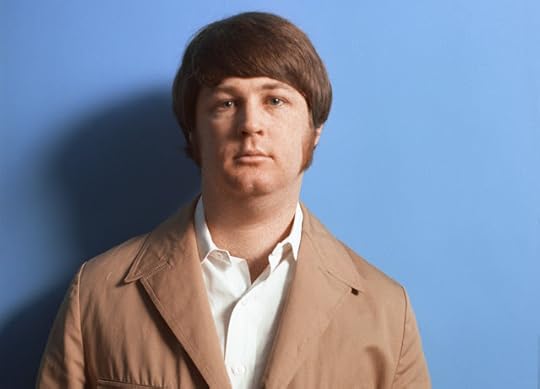
Published on April 05, 2018 06:13
April 4, 2018
Re-Post: When Rock 'n' Roll Became Rock
 Music evolves, goes from 8 track to 16 to digital, takes on a new parlance, someone messes with a Coke can or a hurdy-gurdy, with tape loops and feedback, but 50 years ago, pop music changed its meaning. In July '65, unabashed back-alley hooligans, The Rolling Stones, hit No. 1 with "Satisfaction," a song in which witty complaints about sexual frustration and social hypocrisy sowed the seeds of genuine protest. The next month, Dylan's "Like a Rolling Stone" shot to No. 2, fired by poetic language that spoke of the freedom, and the fear, of leaving social conventions behind. By October it was full tilt with Barry McGuire's "Eve of Destruction," and in December The Who (more riff-raff) released "My Generation," a stammering, in your face, take no shit anthem that drew a violent line in the sand between young and old. The Generation Gap had arrived. To mark so huge a sea change, the sound got a new title — or at least an amended one: the music previously known as "rock 'n' roll" morphed into the emphatic, yet simply named "rock." Like when dungarees became jeans and stayed that way.
Music evolves, goes from 8 track to 16 to digital, takes on a new parlance, someone messes with a Coke can or a hurdy-gurdy, with tape loops and feedback, but 50 years ago, pop music changed its meaning. In July '65, unabashed back-alley hooligans, The Rolling Stones, hit No. 1 with "Satisfaction," a song in which witty complaints about sexual frustration and social hypocrisy sowed the seeds of genuine protest. The next month, Dylan's "Like a Rolling Stone" shot to No. 2, fired by poetic language that spoke of the freedom, and the fear, of leaving social conventions behind. By October it was full tilt with Barry McGuire's "Eve of Destruction," and in December The Who (more riff-raff) released "My Generation," a stammering, in your face, take no shit anthem that drew a violent line in the sand between young and old. The Generation Gap had arrived. To mark so huge a sea change, the sound got a new title — or at least an amended one: the music previously known as "rock 'n' roll" morphed into the emphatic, yet simply named "rock." Like when dungarees became jeans and stayed that way.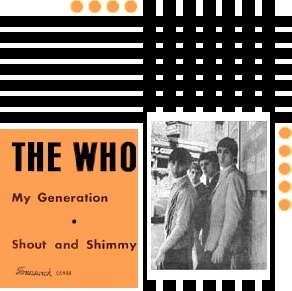 There is only speculation of the term rock 'n' roll, though one sexually explicit ditty comes to mind, Trixie Smith's 1922 "My Man Rocks Me (With One Steady Roll)". Others may suggest the household standard "Rock-a-bye Baby" from 1809 as the term's catalyst, but that's just dumb. Rock, if not sexually motivated, is at a minimum motivated in passion, and it was in 1965 that that that passion became a lifestyle, a movement, a reason to leave home and converge on Frisco bay, to smoke dope and protest the war, to "turn on, drop out and tune in." That phrase wasn't popularized by Leary until '66, but it's this writer's opinion that it was the music, "rock" to be specific, that inspired the events of the Summer of Love and Woodstock and not exclusively the other way around. The Beatles (The Stones, as well and so many more), were a product and a catalyst of their time.
There is only speculation of the term rock 'n' roll, though one sexually explicit ditty comes to mind, Trixie Smith's 1922 "My Man Rocks Me (With One Steady Roll)". Others may suggest the household standard "Rock-a-bye Baby" from 1809 as the term's catalyst, but that's just dumb. Rock, if not sexually motivated, is at a minimum motivated in passion, and it was in 1965 that that that passion became a lifestyle, a movement, a reason to leave home and converge on Frisco bay, to smoke dope and protest the war, to "turn on, drop out and tune in." That phrase wasn't popularized by Leary until '66, but it's this writer's opinion that it was the music, "rock" to be specific, that inspired the events of the Summer of Love and Woodstock and not exclusively the other way around. The Beatles (The Stones, as well and so many more), were a product and a catalyst of their time.It was 50 years ago that rock took on a new significance, one that had been the job of folk and then Dylan went electric to a cacophony of ballyhoo - but for a moment - and then no one cared anymore. We can argue all we want over rock's greatest year, '67? '72?, IDK, everything from Revolver to My Aim is True, but you can't argue that it was '65 when rock got real.
Published on April 04, 2018 11:58
Story Goes... Satisfaction
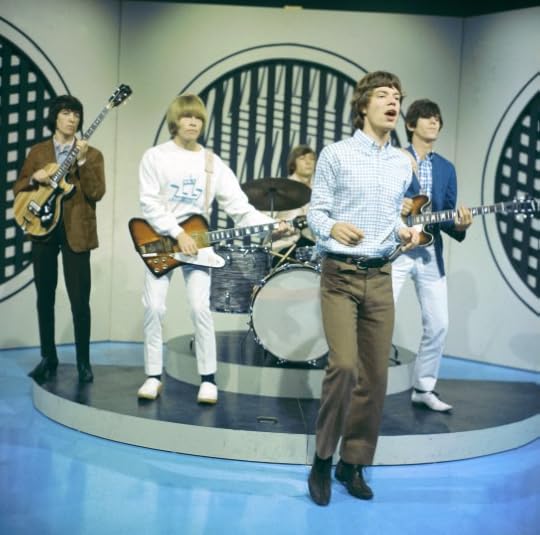 From Elvis and The Beatles on Ed Sullivan to Eric Clapton playing "Crossroads" with Cream in a tribute to idol Robert Johnson (1968, Winterland Ballroom), The Story Goes segment could go on indefinitely, but we're looking at those moments that truly affected what was yet to come. While "The Day the Music Died" (February 3, 1959) is an extreme example metaphorically of the 50s evolving into the 60s (in nearly the same way that Altamonte signaled a death knell to the 60s), each of these events led to little inherent and dramatic change in the genre. And while Bob Dylan "plugged in" at the Newport Jazz Festival in July 1965, Keith Richards awoke to find that his new reel to reel was at the end of its tape, still spinning.
From Elvis and The Beatles on Ed Sullivan to Eric Clapton playing "Crossroads" with Cream in a tribute to idol Robert Johnson (1968, Winterland Ballroom), The Story Goes segment could go on indefinitely, but we're looking at those moments that truly affected what was yet to come. While "The Day the Music Died" (February 3, 1959) is an extreme example metaphorically of the 50s evolving into the 60s (in nearly the same way that Altamonte signaled a death knell to the 60s), each of these events led to little inherent and dramatic change in the genre. And while Bob Dylan "plugged in" at the Newport Jazz Festival in July 1965, Keith Richards awoke to find that his new reel to reel was at the end of its tape, still spinning. 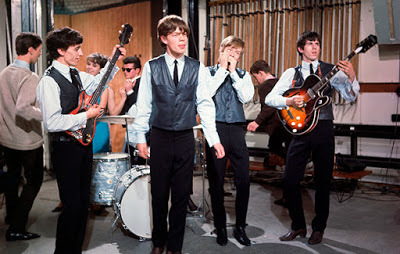 Puzzled, he rewound it to find rock and roll's greatest guitar riff along with the words "I can't get no satisfaction," and followed by forty minutes of his own snoring. "I was asleep, I woke up and without even knowing it, I pushed play on my little early cassette player, played it, went back to sleep, and didn’t remember a thing about it until I saw the tape had run to the other end," Aside from the snoring, there was enough for him to play the now iconic riff, the most recognizable in rock, to Mick Jagger, who envisioned its potential (though it took a while) and swung into action, finishing the song. With verses written by Jagger, the Stones took the song into Chess Studios in Chicago just three days later, May 10, 1965, and completed it on May 12 after a flight to Los Angeles and an 18-hour recording session at RCA. It was there that Richards hooked up an early Gibson version of a fuzz box to his guitar and played the riff he initially envisioned being played by horns. Though the Stones at the time were already midway through their third U.S. tour, their only bona fide American hits to date were "Time Is On My Side" and the recently released "The Last Time." "Satisfaction" was the song that would catapult them to superstar status.
Puzzled, he rewound it to find rock and roll's greatest guitar riff along with the words "I can't get no satisfaction," and followed by forty minutes of his own snoring. "I was asleep, I woke up and without even knowing it, I pushed play on my little early cassette player, played it, went back to sleep, and didn’t remember a thing about it until I saw the tape had run to the other end," Aside from the snoring, there was enough for him to play the now iconic riff, the most recognizable in rock, to Mick Jagger, who envisioned its potential (though it took a while) and swung into action, finishing the song. With verses written by Jagger, the Stones took the song into Chess Studios in Chicago just three days later, May 10, 1965, and completed it on May 12 after a flight to Los Angeles and an 18-hour recording session at RCA. It was there that Richards hooked up an early Gibson version of a fuzz box to his guitar and played the riff he initially envisioned being played by horns. Though the Stones at the time were already midway through their third U.S. tour, their only bona fide American hits to date were "Time Is On My Side" and the recently released "The Last Time." "Satisfaction" was the song that would catapult them to superstar status. It's not often that AM and Rolling Stone are on the same page, but with this, "That spark in the night…was the crossroads: the point at which the rickety jump and puppy love of early rock and roll became rock," RS is spot on.
Published on April 04, 2018 05:50
April 3, 2018
Story Goes... Sun Records and Elvis
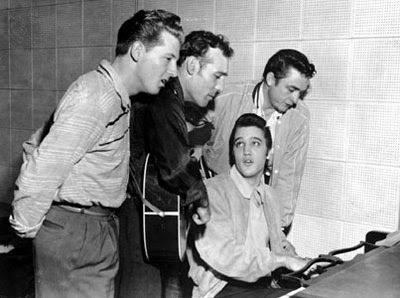 The Million Dollar Quartet at Sun StudiosElvis died 41 years ago. I've always felt a little responsible. I fell asleep in the afternoon with the TV on. I dreamt that Elvis was dead. And when I awoke, it was on the Big News with Jerry Dunphey. He confirmed it. Elvis was dead and it was my fault.
The Million Dollar Quartet at Sun StudiosElvis died 41 years ago. I've always felt a little responsible. I fell asleep in the afternoon with the TV on. I dreamt that Elvis was dead. And when I awoke, it was on the Big News with Jerry Dunphey. He confirmed it. Elvis was dead and it was my fault.Journalist Tony Scherman stated in his Elvis bio that by early 1977, "Presley had become a grotesque caricature of his sleek, energetic former self. Hugely overweight, his mind dulled by the pharmacopia he daily ingested, he was barely able to pull himself through his abbreviated concerts." The next few nights of the tour proved a disaster with Elvis in Baton Rouge unable to get out bed, his biography more and more resembling that of Howard Hughes. The fall of the King, though, while fascinating, isn't AM's style; instead, let's venture back to Sun Studios where, alongside Carl Perkins, Jerry Lee Lewis and Johnny Cash, it all began.
In 1956, President Dwight D. Eisenhower signed the Federal Aid Highway Act, creating the Interstate Highway System, Marilyn Monroe married playwright Arthur Miller, heavyweight boxing champion, Rocky Marciano, retired, having never lost a match, and Elvis Presley was on track to become a national pop sensation. In the previous year, Elvis and his band had toured much of the country, especially in the south, getting rave reviews (indeed, Elvis performed 260 times over the course of the year). On January 28th, Elvis made his first national television appearance on the Dorsey Brother's Stage Show, recorded and broadcast on CBS. After the success of Elvis’ first appearance, he was signed to five more shows in February and March that year. Meanwhile, by late February "Heartbreak Hotel" entered the national music charts for the first time. A month later he released his eponymous, genre-changing first album, Elvis Presley. On June 5th, Elvis introduced his new song, “Hound Dog” during a national TV appearance on The Milton Berle Show, "scandalizing the audience with his suggestive hip movements." The August 7th edition of Look magazine, with Prince Philip on the cover, appeared on newsstands with an Elvis tagline that read: "Elvis Presley: What? Why?" Inside it read, "…but Presley is mostly nightmare. On stage, his gyrations are vulgar. He has also dragged 'big beat' music to new lows in taste."
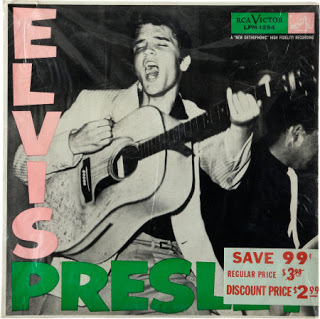 60 Years AgoThere are watershed moments in music, the most apparent of which is the release of Sgt. Pepper in 1967. Sgt. Pepper was the moment when rock became more than teen frivolity – The Beatles had elevated rock to an art form. That progression began with Elvis 60 years ago at Sun Records, the Genesis of it coming in December 1956 at Sun Studios when Carl Perkins, Johnny Cash and Jerry Lee Lewis huddled around Elvis Presley at an upright piano – The Million Dollar Quartet. Even before that, though, an equally iconic moment happened in that same studio. It was on July 5, 1954 that Elvis, a 17-year-old truck driver who presented himself as a ballad singer but sucked at every ballad he was offered, suddenly and inexplicable reinvented himself. On a break from his torchy mediocrity, Elvis broke into a rockabilly version of "That's All Right." It was all about blues, country, sex, and freedom and instantly rock 'n' roll had its first and definitive idol.
60 Years AgoThere are watershed moments in music, the most apparent of which is the release of Sgt. Pepper in 1967. Sgt. Pepper was the moment when rock became more than teen frivolity – The Beatles had elevated rock to an art form. That progression began with Elvis 60 years ago at Sun Records, the Genesis of it coming in December 1956 at Sun Studios when Carl Perkins, Johnny Cash and Jerry Lee Lewis huddled around Elvis Presley at an upright piano – The Million Dollar Quartet. Even before that, though, an equally iconic moment happened in that same studio. It was on July 5, 1954 that Elvis, a 17-year-old truck driver who presented himself as a ballad singer but sucked at every ballad he was offered, suddenly and inexplicable reinvented himself. On a break from his torchy mediocrity, Elvis broke into a rockabilly version of "That's All Right." It was all about blues, country, sex, and freedom and instantly rock 'n' roll had its first and definitive idol.Sun Records was founded, along with Sun Studios in Memphis, Tennessee by Sam Phillips in 1952. After leaving the service, Phillips worked as a deejay and engineer at WLAY in Muscle Shoals, Alabama. By 1946 he hosted a daily show at WREC, Memphis called "Songs of the West." There, Phillips developed the signature sound that he'd take into the recording studio. With Jackie Brenston and his Delta Cats (later recognized as Ike Turner's Kings of Rhythm with Brenston on vocals), Phillips produced Chess Records' proto-rock R&B hit "Rocket 88," the first true rock n roll record, (a 10 in. 78, by the way).
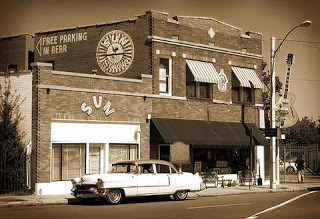 Elvis Presley came to Sun Records paying $4 to record songs for his mother's birthday. In June and July 1954, at the urging of his secretary, Sam Phillips invited Elvis back to the studio to record other tracks, including "That's All Right, Mama" (Sun 204). Traditionally, it's said that with Elvis Presley, Sun Records and Sam Phillips mashed together white musicians with black music, country music and rhythm and blues thus igniting the rock 'n' roll era. Eventually, Sun Records sold Elvis' contract to RCA and Col. Tom Parker for $40,000, a then unheard of sum. Before Elvis departed, Sam Phillips recruited other top talent including Jerry Lee Lewis, Carl Perkins, and Johnny Cash who on December 4, 1956 recorded and released an impromptu session referred to as The Million Dollar Quartet. The resulting recording is less than impressive from a production standpoint (essentially Sam Phillips just recorded the impromptu meeting), but the session itself represents one of rock music's astounding historical moments.
Elvis Presley came to Sun Records paying $4 to record songs for his mother's birthday. In June and July 1954, at the urging of his secretary, Sam Phillips invited Elvis back to the studio to record other tracks, including "That's All Right, Mama" (Sun 204). Traditionally, it's said that with Elvis Presley, Sun Records and Sam Phillips mashed together white musicians with black music, country music and rhythm and blues thus igniting the rock 'n' roll era. Eventually, Sun Records sold Elvis' contract to RCA and Col. Tom Parker for $40,000, a then unheard of sum. Before Elvis departed, Sam Phillips recruited other top talent including Jerry Lee Lewis, Carl Perkins, and Johnny Cash who on December 4, 1956 recorded and released an impromptu session referred to as The Million Dollar Quartet. The resulting recording is less than impressive from a production standpoint (essentially Sam Phillips just recorded the impromptu meeting), but the session itself represents one of rock music's astounding historical moments. 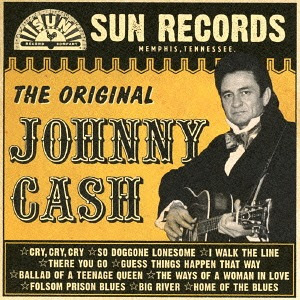 Elvis dominates this session (with Johnny Cash's input negligible and no recordings exist of the star's lead contributions), but Jerry Lee Lewis is also prominent throughout. Carl Perkins remains in the background, taking the lead only on "Keeper of the Key." Elvis' tremendous gospel take comes through loud and clear on "Just a Little Walk With Jesus," "Peace in the Valley," and "Down By the Riverside," and Jerry Lee's strong backup on these songs shows a tremendous sense of confidence. Soon the guys shift to bluegrass, giving us snippets of several Bill Monroe classics, then the real fun begins: Elvis explains how the song "Don't Forbid Me" sat in his house for months without his knowing about it, although it was written for him, with Pat Boone ultimately recording it. Then the guys honor Chuck Berry, repeatedly returning to the "Brown Eyed Handsome Man." Jerry Lee seemingly loves the line about Venus losing both of arms while wrestling to win herself a "brown eyed handsome man." The greatest part of this session, to my mind, is Elvis' imitation of an imitation of his "Don't Be Cruel." He talks about seeing Jackie Wilson perform the song in Las Vegas. He was so impressed that he went back four straight nights just to hear it. Elvis' imitation of Jackie's imitation of his own song is really something special. These recordings are essential, if just for the history and for the exact moment when rock 'n' roll was born.
Elvis dominates this session (with Johnny Cash's input negligible and no recordings exist of the star's lead contributions), but Jerry Lee Lewis is also prominent throughout. Carl Perkins remains in the background, taking the lead only on "Keeper of the Key." Elvis' tremendous gospel take comes through loud and clear on "Just a Little Walk With Jesus," "Peace in the Valley," and "Down By the Riverside," and Jerry Lee's strong backup on these songs shows a tremendous sense of confidence. Soon the guys shift to bluegrass, giving us snippets of several Bill Monroe classics, then the real fun begins: Elvis explains how the song "Don't Forbid Me" sat in his house for months without his knowing about it, although it was written for him, with Pat Boone ultimately recording it. Then the guys honor Chuck Berry, repeatedly returning to the "Brown Eyed Handsome Man." Jerry Lee seemingly loves the line about Venus losing both of arms while wrestling to win herself a "brown eyed handsome man." The greatest part of this session, to my mind, is Elvis' imitation of an imitation of his "Don't Be Cruel." He talks about seeing Jackie Wilson perform the song in Las Vegas. He was so impressed that he went back four straight nights just to hear it. Elvis' imitation of Jackie's imitation of his own song is really something special. These recordings are essential, if just for the history and for the exact moment when rock 'n' roll was born.My son and I took a ten day road trip from the East Coast to the Grand Canyon this past July. After 16 hours in the car, we finally made it to Memphis. Time constraints didn't allow for Graceland, but Sun Studios was imperative. The tour inspired in me, and my son as well, different sensibility with regard to Elvis. I grew up with Elvis movies (Viva Las Vegas a mid-century biopic), the music eluding me for the most part, but Elvis' celebrity was tarnishing before our eyes. The fat, bespangled, caricature of Elvis in the white fringed jump suit pervaded my sensibilities. At Sun Studios (more accurately Sam Phillips Recording), that Elvis doesn't exist; the studio is simply a celebration of the rise of the King, his contemporaries and the Sam Phillips innovations that injected the lifeblood into rock 'n' roll. (Oh, and my son and I got to sing into Elvis' mic!)
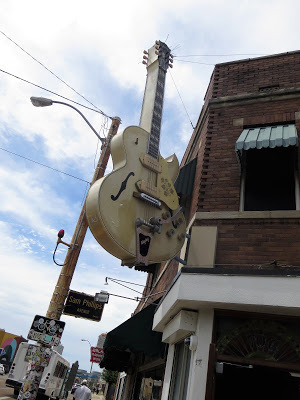 Mostly through the encouragement of his assistant and studio manager, Marion Keisker, Phillips began contemplating a young man who'd come in a couple of times to record for his mother. No suspense here; it was Elvis Presley. Phillips wasn't particularly interested in his style. Then, by chance, Presley started singing an old blues number, "That's All Right, Mama." Passing by the control room, Phillips heard what was going on, turned on the recording machines and urged Presley to start again, upping the tempo. It became Elvis' first big hit. Despite the record's success, Phillips ran short of cash and, in November 1955, sold Elvis' contract to RCA for $35,000 - worth $350,000 today - the most ever paid for any artist to that point. While Phillips used the money to promote the studio and artists like Roy Orbison and Charlie Rich, it was a move not dissimilar to the Boston Red Sox trading Babe Ruth; indeed Sam Phillips' only "oops."
Mostly through the encouragement of his assistant and studio manager, Marion Keisker, Phillips began contemplating a young man who'd come in a couple of times to record for his mother. No suspense here; it was Elvis Presley. Phillips wasn't particularly interested in his style. Then, by chance, Presley started singing an old blues number, "That's All Right, Mama." Passing by the control room, Phillips heard what was going on, turned on the recording machines and urged Presley to start again, upping the tempo. It became Elvis' first big hit. Despite the record's success, Phillips ran short of cash and, in November 1955, sold Elvis' contract to RCA for $35,000 - worth $350,000 today - the most ever paid for any artist to that point. While Phillips used the money to promote the studio and artists like Roy Orbison and Charlie Rich, it was a move not dissimilar to the Boston Red Sox trading Babe Ruth; indeed Sam Phillips' only "oops."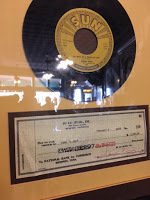 Elvis returned to Sun, if just for a day (December 4, 1956), and met up with Cash, Perkins and Lewis, the since named Million Dollar Quartet. From the Sun Records Website: "Sometime in the early afternoon, Elvis Presley, a former Sun artist himself, but now at RCA, dropped in to pay a casual visit accompanied by a girlfriend, Marilyn Evans. He was, at the time, the biggest name in show business, having hit the top of the singles charts five times, and topping the album charts twice in the preceding 12 month period. Less than four months earlier, he had appeared on The Ed Sullivan Show, pulling an unheard-of 83% of the television audience, which was estimated at 55 million, the largest in history, up to that time. After chatting with Philips in the control room, Presley listened to the playback of the Perkins’ session, which he pronounced to be good. Then he went into the studio and sometime later the jam session began. Phillips left the tapes running in order to 'capture the moment' as a souvenir and for posterity. At some point during the session, Sun artist Johnny Cash, who had also enjoyed a few hits on the country charts, popped in (Cash noted in his autobiography that it was he who was the first to arrive at Sun Studio that day). As Jerry Lee pounded away on the piano, Elvis and his girlfriend at some point slipped out. Cash claims that “no one wanted to follow Jerry Lee, not even Elvis.
Elvis returned to Sun, if just for a day (December 4, 1956), and met up with Cash, Perkins and Lewis, the since named Million Dollar Quartet. From the Sun Records Website: "Sometime in the early afternoon, Elvis Presley, a former Sun artist himself, but now at RCA, dropped in to pay a casual visit accompanied by a girlfriend, Marilyn Evans. He was, at the time, the biggest name in show business, having hit the top of the singles charts five times, and topping the album charts twice in the preceding 12 month period. Less than four months earlier, he had appeared on The Ed Sullivan Show, pulling an unheard-of 83% of the television audience, which was estimated at 55 million, the largest in history, up to that time. After chatting with Philips in the control room, Presley listened to the playback of the Perkins’ session, which he pronounced to be good. Then he went into the studio and sometime later the jam session began. Phillips left the tapes running in order to 'capture the moment' as a souvenir and for posterity. At some point during the session, Sun artist Johnny Cash, who had also enjoyed a few hits on the country charts, popped in (Cash noted in his autobiography that it was he who was the first to arrive at Sun Studio that day). As Jerry Lee pounded away on the piano, Elvis and his girlfriend at some point slipped out. Cash claims that “no one wanted to follow Jerry Lee, not even Elvis."The following day, an article, written by Memphis newspaperman Bob Johnson about the session, was published in the Memphis Press-Scimitar under the title, "Million Dollar Quartet." The article contained the now well known photograph of Elvis Presley seated at the piano surrounded by Jerry Lee Lewis, Carl Perkins and Johnny Cash."
Published on April 03, 2018 15:06
Story Goes...
AM relies a lot on that instrumental moment when rock 'n' roll became rock; namely with the release of "Satisfaction" in June 1965, though certainly the history of our music has roots that go back much further, into the 40s or even the 20s. AM's focus on rock doesn't discount or ignore Sun Records or Robert Johnson or the Bristol Sessions of 1927 (the Genesis of country music), yet we've never really delved into the timeline that brought on rock's golden era from 1967 through the mid-70s. While this series will focus on rock's evolution over time, there are indeed moments that stand out in its early history. While the release in June 1967 marks the single most important time for rock music, namely, the release of Sgt. Pepperby The Beatles, by then we were fully immersed in the genre, and while the LP is the Huck Finn of modern music, like a Scooby Doo flashback, there were indeed far more important events that led up the Pepper.
And so, here is both the mythology, buy into it if you will, and also the first important moment in rock's storied history:
Story goes, Delta bluesman Son House, just couldn't stand it no more. Robert Johnson plain couldn't play; like he was guttin' a cat. Down in Yazoo City folks'd say, "Why don’t you all go in there and make that boy put that thing down. He’s runnin’ us crazy!" And he chased young Robert away. Now young Rob was all 'bout three things: guitars, hooch and womens. so picture him down at the crossroads outside-a Rosedale, dark and lonesome, dog howlin' in a ditch 'longside the road. He be headin' no doubt to Gunnison, knows people, mindin' his own, when a grifter, sittin' on a log off the side of the road says, "You're late, Robert Johnson." Robert Johnson drops to his knees and says, "Maybe not."
The man stands up, tall as tall and black as forever, says, "Stand up, Robert Johnson. You want to play that guitar like you like all the rest, 'cept worst. You heard em: 'runnin' us crazy,' or or you wanna play that guitar like nobuddy ever played before? Make a sound nobuddy ever heard before? You want to be the King of the Delta Blues and have all the whiskey and women you want?"
"That's a lot of whiskey and women, Devil-Man." Devil played him some guitar like Robert don’t never hear and he say, "I got to have that sound, Devil-Man. That sound is mine. Where do I sign?" Sold his soul right on the spot. The man says, "You ain’t got a pencil, Robert Johnson. Your word is good enough - But you better be prepared. There are consequences." Devil said, "My left hand will be forever wrapped around your soul, and your music will possess all who hear it. That's what's gonto happen. That's what you better be prepared for. Your soul will belong to me." Devil said, "This ain't just any crossroads. I put this "X" here for a reason, and I been waiting on you." But Robert, he wernt listening.
When he come back to Yazoo, Willie Brown was playin', and Robert, he says, "Can I hit a lick or two?" but Son House, he says, "Don't come back with that, Robert Johnson. You know that folks don’t all want to hear that racket." Now young Robert he says, "Let them say what they want. I want you to see what I learnt," and when he finished all their mouths were standing open.
- That was the day rock 'n' roll began. Though there is no definitive date involved, let's call it 1931. Son House moved to Rosedale in 1929, so it could be earlier, but all accounts point to House being well established when he told Robert Johnson that he was runnin' everyone crazy.
Published on April 03, 2018 06:34
Talking 'bout an Evolution...
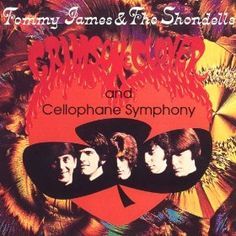 The mid-sixties were like VOCs (Volatile Organic Compounds), willy-nilly in their stabilly. The Beatles dismissed touring because they couldn't hear themselves think and found their Genius within the sheltered confines of the studio. Tommy James and the Shondells were bubble gum staples until they went psychedelic with "Crimson and Clover" and "Crystal Blue Persuasion." Brian Wilson just stayed home.
The mid-sixties were like VOCs (Volatile Organic Compounds), willy-nilly in their stabilly. The Beatles dismissed touring because they couldn't hear themselves think and found their Genius within the sheltered confines of the studio. Tommy James and the Shondells were bubble gum staples until they went psychedelic with "Crimson and Clover" and "Crystal Blue Persuasion." Brian Wilson just stayed home. As rock went from teenage angst to protest and drugs it swept every loose band along with it. One need look no further than the 1st Edition's "Just Dropped In (To See What Condition My Condition Is In)" featuring Kenny Rogers. This is the "Ruby" guy we're talking about, right, the one who knows when to hold 'em? Yeah, well in 1967 he was "holding" a tab of lysergic acid diethylamide 25.
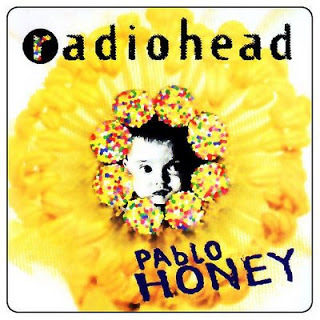 The evolution from Radiohead's Pablo Honey to A Moon Shaperd Pool is jarring and perfunctory, but fabulous – there's no question that child was father to the man. Talk Talk morphed from 80s techno to 90s art rock without a hiccough. The BeeGees reinvented their folky-psychedelia with disco, and I for one, despite the incredible hits of the early years, there is still indeed something electric about "Stayin' Alive" that makes you want to strut through Bay Ridge like Tony Manero, even if disco makes you cringe).
The evolution from Radiohead's Pablo Honey to A Moon Shaperd Pool is jarring and perfunctory, but fabulous – there's no question that child was father to the man. Talk Talk morphed from 80s techno to 90s art rock without a hiccough. The BeeGees reinvented their folky-psychedelia with disco, and I for one, despite the incredible hits of the early years, there is still indeed something electric about "Stayin' Alive" that makes you want to strut through Bay Ridge like Tony Manero, even if disco makes you cringe).But the Genesis that stemmed from the Beatles walking off stage or Brian filling his living room with beach sand was an element of its time. 1965 was the Big Bang of rock. Don't bother to look beyond the "Go Now"-plus-fluff-LP that was The Magnificent Moodys. Like many bands of the time, even The Beatles, the debut LP was rampant with covers – even its smash hit, "Go Now." Of course for the Moodys, a new lineup would alter the heart of the band for decades to come. Denny Laine (Wings) and Clint Warwick would leave by the end of '65 and the shift from The Magnificent Moodys to Days of Future Past (AM10) is nothing but phenomenal.
 Fleetwood Mac formed in the mid-60s as an offshoot of John Mayall and the Bluesbreakers, with key members Mick Fleetwood, John McVie and Peter Green. They had a miss with "Black Magic Woman" (soon to be a hit with Santana), and remained, through the early 70s, a British blues band. Mick Fleetwood, interested in a new recording venue (Sound City in Van Nuys, California), asked producer Keith Olsen for a sample of what the studio could offer. Fleetwood was so impressed with the guitarist on that recording – Lindsey Buckingham – that when singer Bob Welch bailed, he asked Buckingham to join the group. Buckingham agreed, but only if his Buckingham Nicks partner, Stevie, could also join. Led by the duo's mainstream rock style, Fleetwood Mac ditched the blues and became mega-stars, with Rumours (AM10) going on to sell more than 40 million copies.
Fleetwood Mac formed in the mid-60s as an offshoot of John Mayall and the Bluesbreakers, with key members Mick Fleetwood, John McVie and Peter Green. They had a miss with "Black Magic Woman" (soon to be a hit with Santana), and remained, through the early 70s, a British blues band. Mick Fleetwood, interested in a new recording venue (Sound City in Van Nuys, California), asked producer Keith Olsen for a sample of what the studio could offer. Fleetwood was so impressed with the guitarist on that recording – Lindsey Buckingham – that when singer Bob Welch bailed, he asked Buckingham to join the group. Buckingham agreed, but only if his Buckingham Nicks partner, Stevie, could also join. Led by the duo's mainstream rock style, Fleetwood Mac ditched the blues and became mega-stars, with Rumours (AM10) going on to sell more than 40 million copies.Based on the jazz-fusion influence of guitarist Mick Abrahams, Jetho Tull’s debut, This Was,despite the clearly defined presence of Ian Anderson, sounded like nothing Tull would ever sound like again. Indeed, NME said of the LP, "They play jazz really, in a soft, appealing way, and have a bit of fun on the side with tone patterns and singing." The metamorphosis from This Was to Stand Up was as extreme as that of the Moodys.
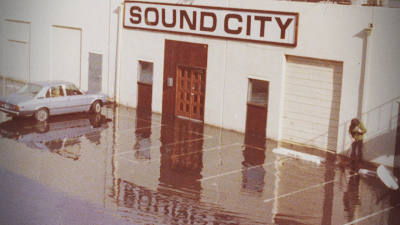 Others on the list: Deep Purple, a progressive jazz band not unlike Soft Machine would flip it around with Deep Purple in Rock (AM7); The Renaissance of Keith Relf was another blues concoction (formed from what was left of the Yardbirds) until Annie Haslam entered the cloister redefining the sound into something unheard of until that time: a female vocal backed by elements of progressive rock, classical, folk and jazz; lastly, not what I would call evolution but the error of its ways, we find Electric Light Orchestra. This isn't devastating, but a sad one for me; not because the pop end of things was so dismal - it wasn't - but because it detracts from the legacy of albums like Eldorado, On the Third Day and Face the Music. The ever wise critics of rock were quick to morph their album's title Discovery (1979), into the oh so depressing Disco Very. I'm at peace with it now, but I was so angry at the time.
Others on the list: Deep Purple, a progressive jazz band not unlike Soft Machine would flip it around with Deep Purple in Rock (AM7); The Renaissance of Keith Relf was another blues concoction (formed from what was left of the Yardbirds) until Annie Haslam entered the cloister redefining the sound into something unheard of until that time: a female vocal backed by elements of progressive rock, classical, folk and jazz; lastly, not what I would call evolution but the error of its ways, we find Electric Light Orchestra. This isn't devastating, but a sad one for me; not because the pop end of things was so dismal - it wasn't - but because it detracts from the legacy of albums like Eldorado, On the Third Day and Face the Music. The ever wise critics of rock were quick to morph their album's title Discovery (1979), into the oh so depressing Disco Very. I'm at peace with it now, but I was so angry at the time.David Bowie would evolve in and out of brilliance for 40 years; Joni would go from folk to jazz; and Tom Waits from a rough and tumble jazz singer to - I'm not even sure. It's that's kind of evolution that punctuates rock's legacy. Rock, like God, is not dead; we only need to sit tight for the next chapter.
Published on April 03, 2018 04:41
April 2, 2018
And in color...
Published on April 02, 2018 08:38

